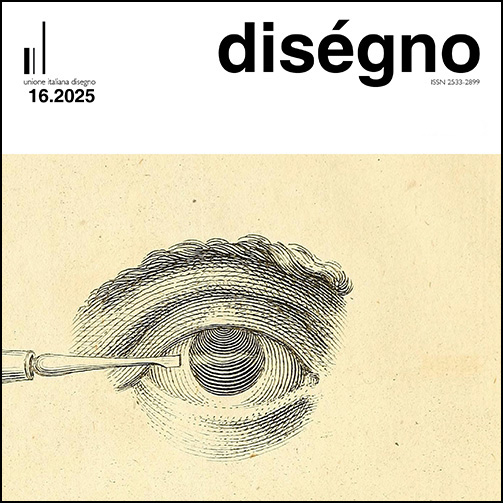Curves and Colors: a Journey into Hundertwasser’s Visual Language
DOI:
https://doi.org/10.26375/disegno.16.2025.23Parole chiave:
Hundertwasser, visual semiotics, drawing, graphic language, colorsAbstract
This paper offers a critical and original reading of Friedensreich Hundertwasser’s work, focusing on the continuity between his visual language in painting and architecture. Moving beyond symbolic or stylistic interpretations, the analysis introduces the concept of atmospheric drawing: a perceptual grammar in which color, line, and texture do not merely represent but generate multisensory and affective environments. Hundertwasser’s graphic signs –spirals, organic curves, chromatic contrasts– are interpreted as compositional devices that activate emotional responses and structure space, both pictorial and architectural. By comparing specific paintings such as Irinaland over the Balkans with buildings like the Hundertwasserhaus or the Waldspirale, the article demonstrates how drawing operates as a generative process that redefines the relationship between humans, architecture, and nature. The concept of the ‘third skin’ is reexamined as a sensory interface, mediating the boundaries between interiority and landscape. Finally, the paper proposes the idea of visual ecology as a framework for understanding drawing as a critical and environmental practice. In doing so, it positions Hundertwasser’s work as a living laboratory for rethinking the role of drawing, not as a static representation of reality, but as a creative tool for shaping how we perceive, inhabit, and imagine the world.
Riferimenti bibliografici
Aroni, G. (2023). Semiotics in Architecture and Spatial Design. In J. Pelkey,
S.W. Matthews (Eds). Bloomsbury Semiotics Volume 2: Semiotics in the Natural and Technical Sciences, pp. 277-296. London: Bloomsbury Academic. <https://doi.org/10.5040/9781350139350.ch-12> (accessed 2 May 2025).
Barak, N. (2017). Hundertwasser - Inspiration for Environmental Ethics: Reformulating the Ecological Self. In Environmental Values, 26(3), pp. 317-342. <https://doi.org/10.3197/096327117X14913285800689> (accessed 2 May 2025).
Chiavoni, E. (2017). Architecture, Colour and Images. Ideas and Designs by Friedensreich Hundertwasser. In Proceedings of the International and Interdisciplinary Conference IMMAGINI? Image and Imagination between Representation, Communication, Education and Psychology. Brixen, Italy, 27–28 November 2017, Vol. 1, No 9, 953. Basel: MDPI. <https://doi.org/10.3390/proceedings1090953> (accessed 2 May 2025).
Derrida, J. (1978). Writing and Difference. Chicago: University of Chicago Press.
Docci, M., Ippolito, A. (2010). The Role of Drawing in 21st Century Design. In Disegnare Idee Immagini, 21, pp. 26-37.
Domazet, S., Nadić, D. (2022). Sustainability and Ecology in the Architecture of Friedensreich Hundertwasser. In Socioloski Pregled, Vol. 56, No 3, pp. 1003-1031. <https://doi.org/10.5937/socpreg56-39245> (accessed 2 May 2025).
Eco, U. (1976). A Theory of Semiotics. Bloomington: Indiana University Press.
Frascina, F., Harrison, C. (1983). Modern Art and Modernism: A Critical Anthology. London: Routledge.
Fürst, A.C. (2002). Hundertwasser 1928-2000, Catalogue Raisonné, Vol. II. Cologne: Taschen.
Gombrich, E.H. (2004). Art and Illusion: A Study in the Psychology of Pictorial Representation. Princeton: Princeton University Press.
Heller, S., Pettit, E. (2004). Graphic Design Time Line: A Century of Design Milestones. New York: Allworth Press.
Hundertwasser, F. (1997). Hundertwasser Architecture: For a More Human Architecture in Harmony with Nature. Cologne: Taschen.
Hundertwasser, F. (1986). The Complete Graphic Work, 1951-1986. New York: Rizzoli.
Hundertwasser, F. (2005). Hundertwasser: 1928-2000. Cologne: Taschen.
Jeong, S. (2018). Mask Art Illustration Using Hundertwasser’s Lines and Colors. In Europe Culture Arts Association, Vol. 9, No 2, pp. 159-178.
Kraftl, P. (2009). Living in an artwork: the extraordinary geographies of the Hundertwasser-Haus,1 Vienna. In Cultural Geographies, Vol. 16, No 1, pp. 111-134. <https://doi.org/10.1177/1474474008097982> (accessed 2 May 2025).
Margolin, V. (1989). Design Discourse: History, Theory, Criticism. Chicago: University of Chicago Press.
Nesbitt, K. (1996). Theorizing a New Agenda for Architecture: An Anthology of Architectural Theory 1965-1995. New York: Princeton Architectural Press.
Pallasmaa, J. (2012). The Eyes of the Skin: Architecture and the Senses. Chichester: Wiley.
Peirce, C. S. (1955). Philosophical Writings of Peirce. New York: Dover Publications.
Restany, P. (2002). Hundertwasser: Il pittore dalle cinque pelli: il potere dell’arte. Köln: Taschen.
Stephens, P., Fürst, A., Walkup, N. (2020). Exploring the Architectural Designs of Hundertwasser. In Art Education, Vol. 74, No 1, pp. 53-57. <https://doi.org/10.1080/00043125.2020.1825591> (accessed 2 May 2025).
Villela, G. (11 November 2012). La Creatività e lo Sviluppo del Sé. Riflessioni a partire dalla Vita e l’Opera di Hundertwasser. In Riunione Scientifica A.I.Psi.
##submission.downloads##
Pubblicato
Come citare
Fascicolo
Sezione
Licenza
Copyright (c) 2025 diségno

TQuesto lavoro è fornito con la licenza Creative Commons Attribuzione 4.0 Internazionale.






